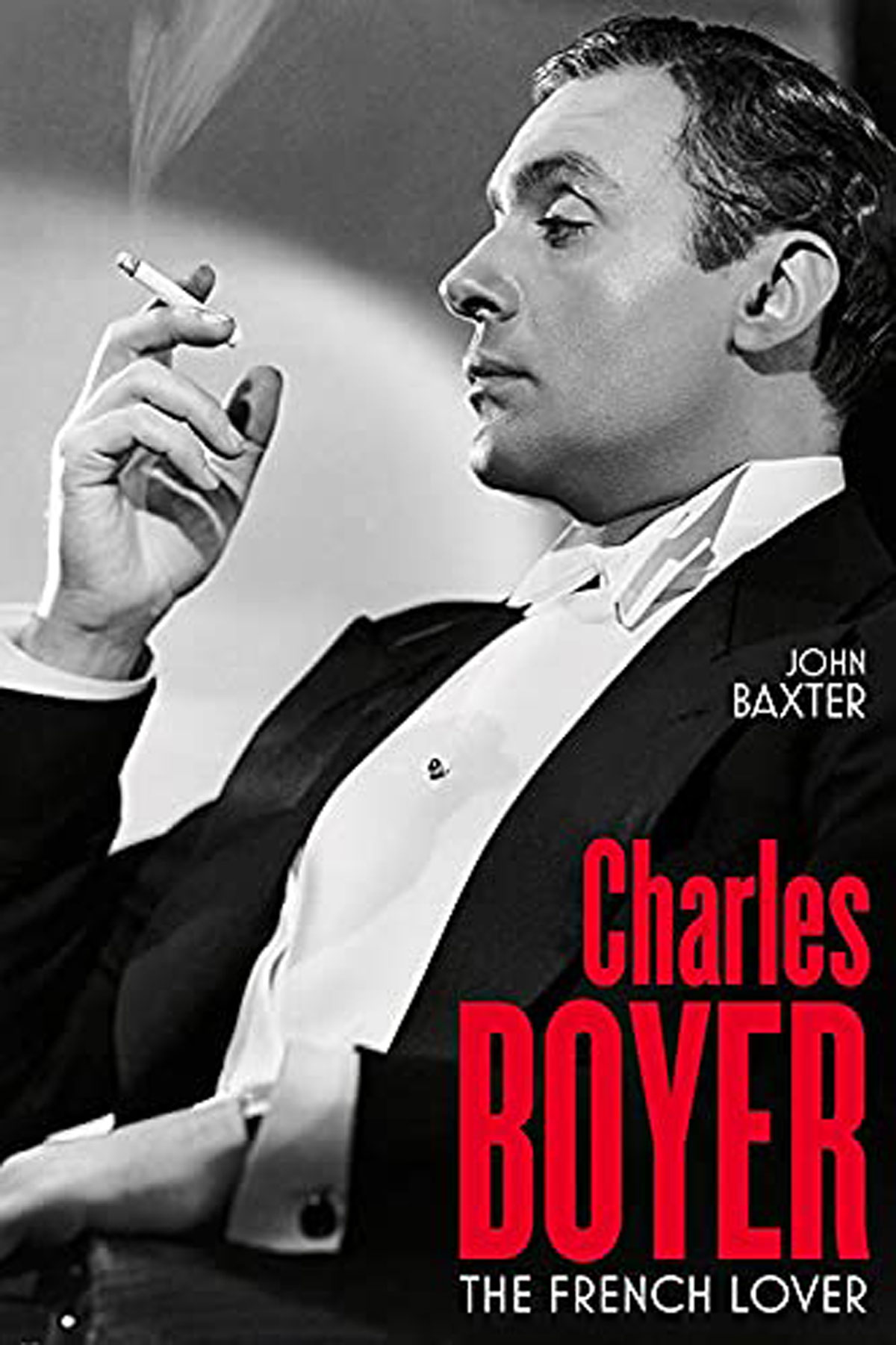John Baxter’s Charles Boyer: The French Lover makes an incisive and long-awaited contribution to film star scholarship by shedding new light on a major, though puzzlingly unprobed, actor of twentieth-century cinema.
The book comprises forty-seven short chapters, charting Boyer’s rise to international fame, through to his eventual tragic end. Baxter sets the scene of Boyer’s birth at the turn of the twentieth century in South-western France, foregrounding his close relationship with his mother, the first to introduce him to the theatres of Paris, then describing the outbreak of World War One just as Boyer’s schooldays are coming to an end. What resonates strongly from the start is Boyer’s deftness and early commitment to the craft of acting, travelling on the road as part of a troupe, performing in national theatres as a ‘second-rate touring actor’ (18), gaining early notoriety for his ‘freakishly good memory’ (18), all the while supplementing his modest income by gambling and playing violin in restaurants. The young Boyer continues performing on stage for a time, most notably at the Théâtre Antoine, before breaking into the film industry via a series of ‘unremarkable’ (22) films in the early 1920s. Baxter traces Boyer’s movements in detail, highlighting the many profitable professional and personal connections made during the early stages of his career. In particular, Baxter draws out the fraternal closeness between Boyer and Maurice Chevalier, reminding the reader that Boyer kept only two framed photographs in his study: one of Chevalier and the other of his beloved mother.
It is clear from the moment that Boyer meets Pat Paterson, his lifelong companion (and a film actress herself), that she will go on to exercise a profound influence on his life, both professional and personal. Despite the couple’s various glittering successes, there is a strong sense throughout that Boyer and Pat each struggle with their own personal experience of repeat melancholy. Even if Pat is captured as a lover of laughter and sociability, her own career stalls as Boyer’s flourishes, leaving her in unexpected (if not lavish) solitude for lengthy periods throughout her life. The rise of European fascism in the late 1930s sends the couple into exile in America, leading to a cutting of ties with Nazi-occupied France. Meanwhile, Boyer continues to devote himself to acting far beyond material necessity.
At various points Baxter’s writing foregrounds Boyer’s characteristic good looks and natural charm, yet ever-present are the ongoing anxieties surrounding his shortness in physical stature, middle-to-late-career hair loss, and the cinematic marketability of his ‘Frenchness’ as he tries to break into Hollywood. Questions recur throughout the decades surrounding Boyer’s ‘heavy’ (38) French accent when performing in English and the impact of his ‘foreigner’ status on casting decisions. Baxter memorably recounts film producer Walter Wanger’s efforts to prepare Boyer for playing Heathcliff in Wuthering Heights (a role that would ultimately go to Laurence Olivier) by employing the services of a voice coach, hoping to: ‘make the Frenchman’s accent more mid-Atlantic’ (81). Elsewhere, in the chapter entitled ‘Think American’, Baxter flags up the especially resonant warning given to Boyer by film director Gregory La Cava: ‘“Until you learn to think in English, you will never reach American audiences”’ (65). While Boyer is described as appreciative of this ‘key insight’ (65), Baxter’s Preface powerfully captures the actor’s enduring struggle with his cinematic identity: ‘Boyer was the archetypal Frenchman – cultivated, courteous, and seductive, yet never quite at home in a culture not his own.’ (vii).
Baxter sensitively conveys the shared emotional intensity of various career highs and lows, teasing out the complex tensions existing between Boyer and some of his most notable co-stars. The most memorable example in this book might just be that of Ingrid Bergman who, while filming intimate scenes with Boyer for the 1944 film Gaslight: ‘turned to mocking him and his physical deficiencies […] She repeatedly mentioned that he stood on a box for some scenes and wore built-up shoes.’ (149). Four years later, however, Bergman speaks publicly in praise of Boyer’s performance in a 1948 Broadway production of Red Gloves (based on the Jean-Paul Sartre play Dirty Hands), declaring: ‘He acted as he always did, with such magic, and held the audience in the palm of his hand.’ (170).
Baxter addresses many of the scandals, clichés and misunderstandings that emerge along the course of Boyer’s career, dispelling the myth surrounding the oft-quoted line ‘Come with me to the Casbah’ from Algiers (the 1938 remake of the Jean Gabin classic Pépé le Moko). This line, with which Boyer is still mistakenly associated today, would go on to dismay the actor for the rest of his career: ‘His sole complaint was that he would be followed and plagued by a line he never said’ (102). The second half of Baxter’s biography, in particular, looks beyond Boyer as cinematic star, bringing to light other projects such as his foray into television production in the 1950s via the series Four-Star Playhouse, prompted by David Niven’s speculation that cinema was becoming ‘a thing of the past’ (179). Baxter also rightfully devotes a short section of the book to Boyer’s only son, Michael, who commits suicide at the age of twenty-one, putting an end to Pat’s ability to put on a good show for the sake of public appearance. Baxter’s biography ends abruptly, allowing the suddenness and shock of Boyer’s own suicide, at the age of seventy-eight, to fully resonate, as indeed it did throughout the cinematic world. The fact that Boyer ends his own life only days after Pat’s death from cancer adds poignantly to the gathering sense that their marriage is a cinematic love story in its own right.
Highly detailed, well-researched and impressive though Baxter’s book is, one undeniable criticism must be the recurring misspellings of film titles and cinematic terminology not only in English, but also in French and German. Students and scholars alike may be surprised to find such editorial slips in what is otherwise a convincing, compelling and long-overdue study of an actor who not only worked alongside some of cinema’s brightest stars but also left an important, even if unspoken until now, legacy of his own.
Competing Interests
The author has no competing interests to declare.

